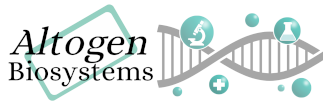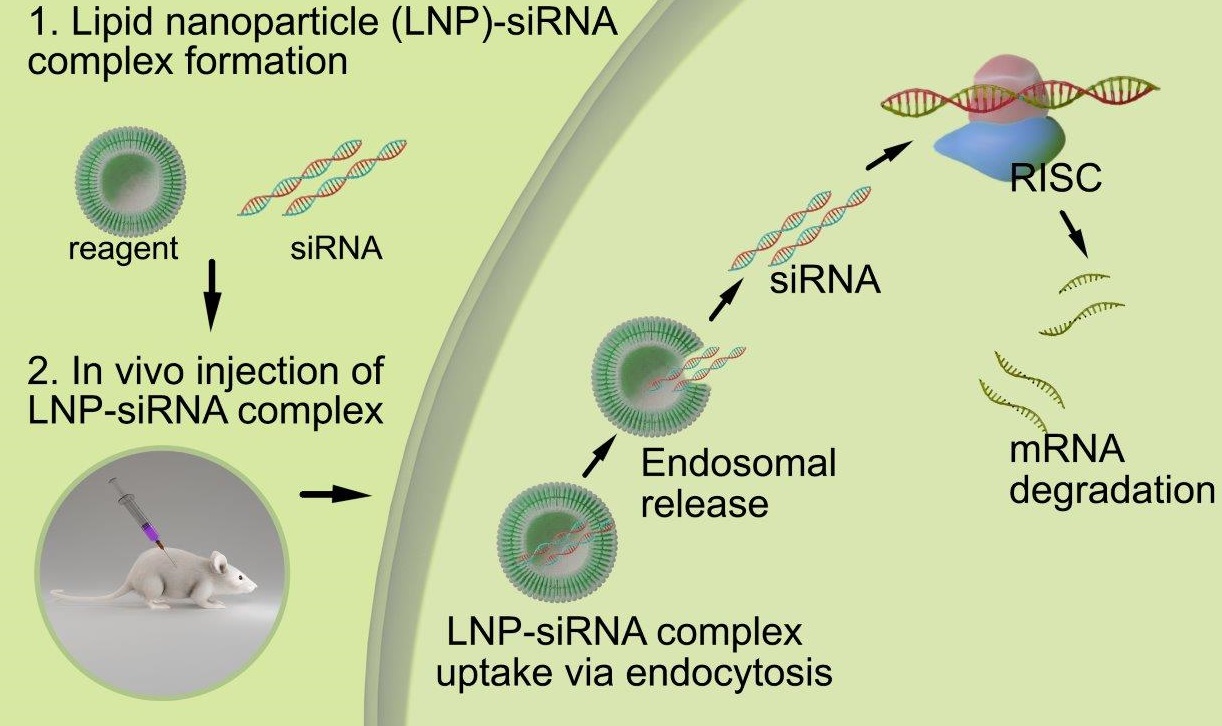Shop Products
In Vivo siRNA Transfection
In Vivo siRNA Transfection (animal siRNA delivery)
In vivo methods require live animal systems where the desired molecule is delivered into the animal or locally to specific tissues. The immune response of the animal will influence the transfection efficiency. By targeting tissue types, such as the brain versus the kidney, a researcher can study the organ’s specific properties and responsiveness to in vivo transfection, thus providing valuable information for the effectiveness of a given drug or compound.
Complications do arise; for example, nucleic acids sensitive to in vivo degradation, such as siRNAs and microRNAs, are degraded by RNAses in vivo within seconds after administration. However, using liposome encapsulation, condensing transfection complexes, and using optimized in vivo transfection protocols and tissue-targeted reagents (see In Vivo Nanoparticle Transfection Kit) can significantly improve and prolong stability in vivo.
RNAi Summary
In animals and plants, RNA interference is part of an immune response to viruses or injection of foreign genetic materials into the cellular structure. This process is recreated by scientists to study gene function through RNAi gene silencing; commercially synthesized siRNAs can be ordered and utilized as a key part of completely separate research on account of siRNA’s crucial role in many experimental processes.
Because of the robust and selective effect RNAi has on gene expression, it has become an invaluable research tool for studies, including in vivo target validation studies using animal models. The major challenge in performing RNAi studies in vivo is the effective, directed delivery of functional siRNA, shRNA, and miRNA molecules into specific tissues. Altogen® In Vivo Transfection Reagents can be conjugated with siRNA and administered intratumorally (i.t) or systemically via an intravenous (i.v) tail vein injection in order to provide directed gene silencing in specific tissues, including liver, pancreas, kidney, and tumors, and selective knockdown can be seen as early as 24 hours after injection.
Gene Silencing via siRNA transfection
Gene silencing by RNA Interference (RNAi) is a powerful research tool for studying gene function in mammalian cells. RNAi is a biological phenomenon by which double stranded RNA (dsRNA) specifically reduces the expression of its corresponding gene. Potent inhibition of specific gene expression is experimentally achieved by the transfection of small interfering RNA (siRNA), which completes the RISC complex and causes degradation of target complementary mRNA molecules in the cell. Successful, potent RNAi experimentation is dependent upon the efficient delivery of the siRNA into cells via transfection of stable and functional siRNA molecules. There is a plethora of protocols and methods that require careful selection to maximize the success of this process.
Most DNA transfection reagents are incompatible with siRNA (which is sensitive to serum) or are capable of inducing cytotoxicity, which negatively affects gene expression studies. Altogen® Transfection Reagents have been developed and optimized specifically for use with siRNA transfection and allow transfection to take place in the presence of serum without lowering the transfection efficiency or reducing cell viability. Ready-to-run transfection protocols eliminate the need for extensive siRNA optimization experiments. Altogen Biosystems kits are compatible with transfection of any negatively charged molecules (including protein, RNA, DNA, and small molecule compounds).
siRNA Transfection Techniques and Details
Since siRNA is generally sensitive to serum and standard chemicals used for more direct forms of transfection, it must be carefully transfected through a variety of less-intense techniques. These can range from liposome encapsulation to nanoparticle-based delivery – such techniques protect the siRNA from degradation and can significantly improve the results of RNAi experiments. Transfection of siRNA usually goes along standard transfection protocols, with the siRNA being mixed with pre-optimized reagents, and then transfected into competent cells.
Several nuances can affect the efficiency of RNAi experiments; the size of transfected compounds (or encapsulations) and the conditions of transfection can both change the outcome of siRNA transfections. For one, siRNA must be released inside of a cell, and hence liposome encapsulation techniques must be precisely measured and optimized for given cell lines. Some cell lines naturally have different interior environments as well – slightly varying pH among different cells and different amounts of naturally-arising compounds also affect the efficiency of transfection. With all these varying factors in mind, it is often better to purchase pre-optimized reagents for given experiments, which have been tested on given cell lines and manufactured to ensure quality. Developing custom reagents is difficult, time-consuming, and usually expensive, while one-time purchases of pre-developed transfection reagents especially for siRNA can help improve experiment reproducibility and effectiveness.
Featured in vivo transfection products from Altogen Biosystems:
In Vivo Nanoparticle Transfection Kit || In Vivo Lipid Transfection Kit || In Vivo Pancreas-targeted Transfection Kit
Altogen Custom Services provides in vivo transfection services and other specialized biotechnology and pharmaceutical services, our contract research services (CRO) are GLP-compliant and include over 90 validated xenograft models, development of stable cell lines, RNA Interference (RNAi) services, assay development, ELISA and Western Blot services, siRNA library screening and transfection services. Generation of stably-expressing cell lines can be very expensive and time-consuming. Altogen Labs offers generation of stable cell line service completed in just 28 days (see service details).
What is In Vivo siRNA Transfection
In vivo siRNA transfection is a technique used to deliver small interfering RNA (siRNA) molecules into living organisms, typically for the purpose of silencing specific genes or treating diseases caused by genetic mutations or overexpression of certain genes.
In vivo siRNA transfection involves the administration of siRNA molecules, which are usually complexed with a delivery vehicle or carrier, such as liposomes or nanoparticles, to a specific tissue or organ in the living organism. The siRNA molecules can then enter the target cells and silence the expression of the target gene by inducing the degradation of the targeted mRNA molecules or inhibiting their translation into proteins.
In vivo siRNA transfection has shown promising results in preclinical studies for the treatment of various diseases, such as cancer, viral infections, and genetic disorders. However, there are challenges associated with the efficient delivery of siRNA molecules to target tissues and organs, and the potential for off-target effects or immune responses.
The development of safe and effective in vivo siRNA transfection strategies is an active area of research, and ongoing studies are aimed at improving the delivery efficiency and reducing the potential risks of this technique.





